check engine Alfa Romeo 4C 2016 Owner handbook (in English)
[x] Cancel search | Manufacturer: ALFA ROMEO, Model Year: 2016, Model line: 4C, Model: Alfa Romeo 4C 2016Pages: 182, PDF Size: 9.49 MB
Page 73 of 182
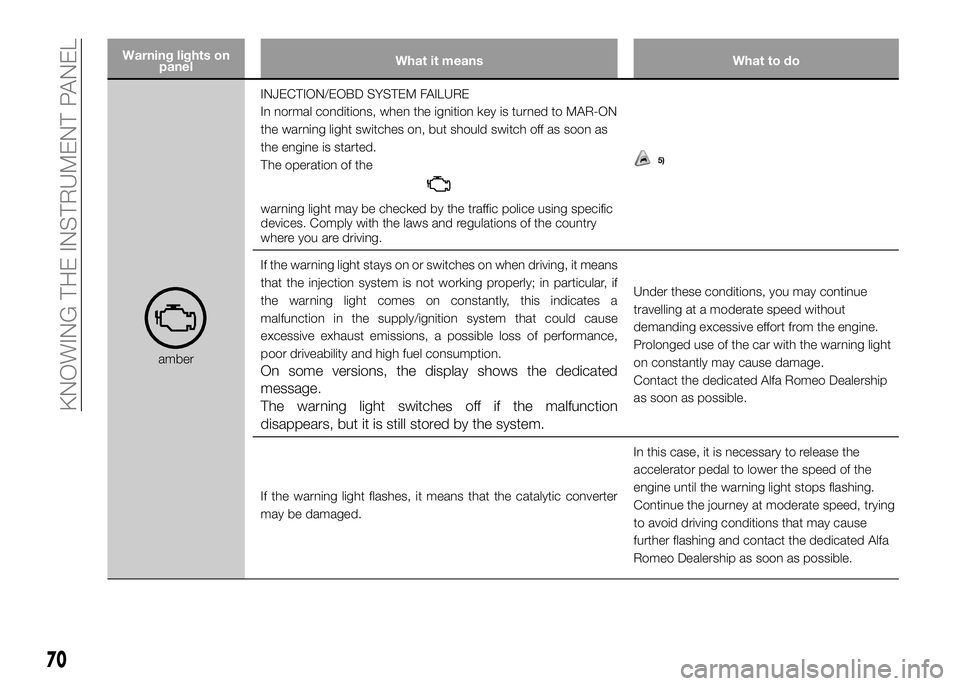
Warning lights on
panelWhat it means What to do
amberINJECTION/EOBD SYSTEM FAILURE
In normal conditions, when the ignition key is turned to MAR-ON
the warning light switches on, but should switch off as soon as
the engine is started.
The operation of the
warning light may be checked by the traffic police using specific
devices. Comply with the laws and regulations of the country
where you are driving.
If the warning light stays on or switches on when driving, it means
that the injection system is not working properly; in particular, if
the warning light comes on constantly, this indicates a
malfunction in the supply/ignition system that could cause
excessive exhaust emissions, a possible loss of performance,
poor driveability and high fuel consumption.
On some versions, the display shows the dedicated
message.
The warning light switches off if the malfunction
disappears, but it is still stored by the system.
Under these conditions, you may continue
travelling at a moderate speed without
demanding excessive effort from the engine.
Prolonged use of the car with the warning light
on constantly may cause damage.
Contact the dedicated Alfa Romeo Dealership
as soon as possible.
If the warning light flashes, it means that the catalytic converter
may be damaged.In this case, it is necessary to release the
accelerator pedal to lower the speed of the
engine until the warning light stops flashing.
Continue the journey at moderate speed, trying
to avoid driving conditions that may cause
further flashing and contact the dedicated Alfa
Romeo Dealership as soon as possible.
70
KNOWING THE INSTRUMENT PANEL
5)
Page 79 of 182
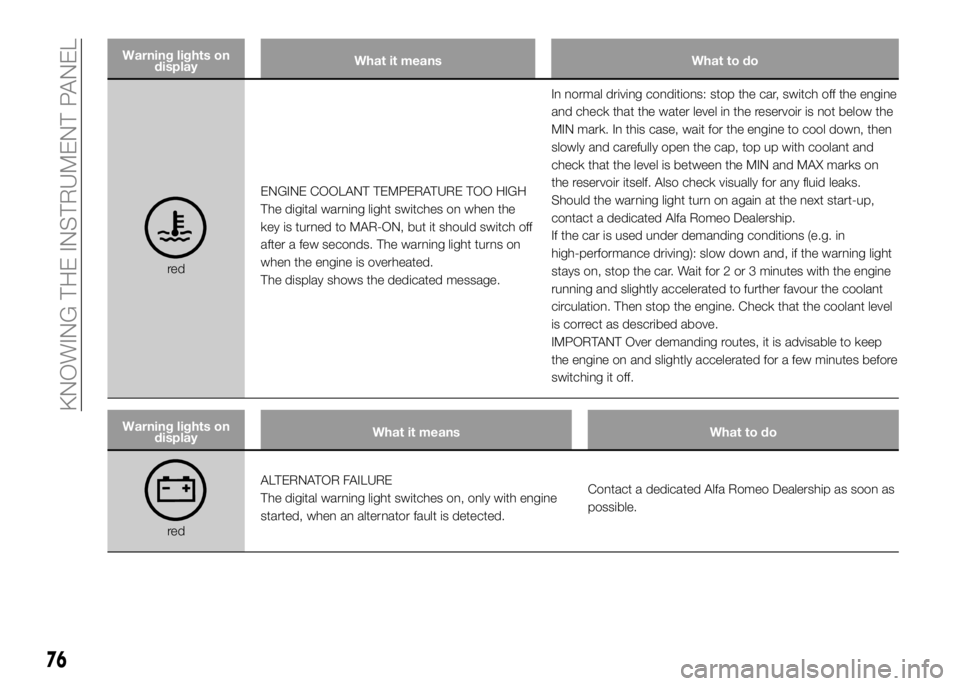
Warning lights on
displayWhat it means What to do
redENGINE COOLANT TEMPERATURE TOO HIGH
The digital warning light switches on when the
key is turned to MAR-ON, but it should switch off
after a few seconds. The warning light turns on
when the engine is overheated.
The display shows the dedicated message.In normal driving conditions: stop the car, switch off the engine
and check that the water level in the reservoir is not below the
MIN mark. In this case, wait for the engine to cool down, then
slowly and carefully open the cap, top up with coolant and
check that the level is between the MIN and MAX marks on
the reservoir itself. Also check visually for any fluid leaks.
Should the warning light turn on again at the next start-up,
contact a dedicated Alfa Romeo Dealership.
If the car is used under demanding conditions (e.g. in
high-performance driving): slow down and, if the warning light
stays on, stop the car. Wait for 2 or 3 minutes with the engine
running and slightly accelerated to further favour the coolant
circulation. Then stop the engine. Check that the coolant level
is correct as described above.
IMPORTANT Over demanding routes, it is advisable to keep
the engine on and slightly accelerated for a few minutes before
switching it off.
Warning lights on
displayWhat it means What to do
redALTERNATOR FAILURE
The digital warning light switches on, only with engine
started, when an alternator fault is detected.Contact a dedicated Alfa Romeo Dealership as soon as
possible.
76
KNOWING THE INSTRUMENT PANEL
Page 96 of 182
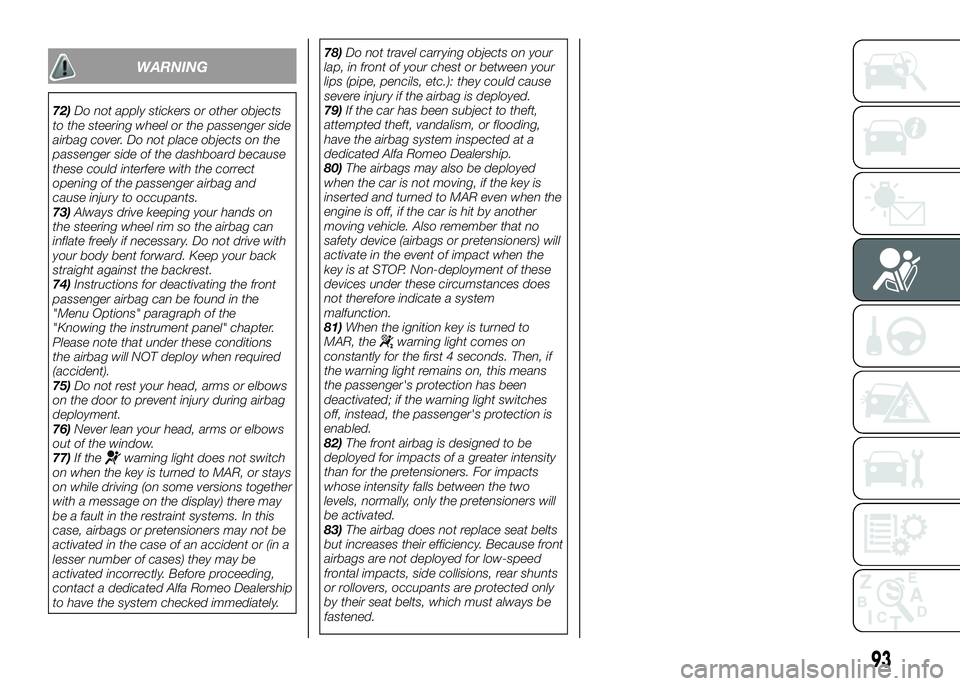
WARNING
72)Do not apply stickers or other objects
to the steering wheel or the passenger side
airbag cover. Do not place objects on the
passenger side of the dashboard because
these could interfere with the correct
opening of the passenger airbag and
cause injury to occupants.
73)Always drive keeping your hands on
the steering wheel rim so the airbag can
inflate freely if necessary. Do not drive with
your body bent forward. Keep your back
straight against the backrest.
74)Instructions for deactivating the front
passenger airbag can be found in the
"Menu Options" paragraph of the
"Knowing the instrument panel" chapter.
Please note that under these conditions
the airbag will NOT deploy when required
(accident).
75)Do not rest your head, arms or elbows
on the door to prevent injury during airbag
deployment.
76)Never lean your head, arms or elbows
out of the window.
77)If the
warning light does not switch
on when the key is turned to MAR, or stays
on while driving (on some versions together
with a message on the display) there may
be a fault in the restraint systems. In this
case, airbags or pretensioners may not be
activated in the case of an accident or (in a
lesser number of cases) they may be
activated incorrectly. Before proceeding,
contact a dedicated Alfa Romeo Dealership
to have the system checked immediately.78)Do not travel carrying objects on your
lap, in front of your chest or between your
lips (pipe, pencils, etc.): they could cause
severe injury if the airbag is deployed.
79)If the car has been subject to theft,
attempted theft, vandalism, or flooding,
have the airbag system inspected at a
dedicated Alfa Romeo Dealership.
80)The airbags may also be deployed
when the car is not moving, if the key is
inserted and turned to MAR even when the
engine is off, if the car is hit by another
moving vehicle. Also remember that no
safety device (airbags or pretensioners) will
activate in the event of impact when the
key is at STOP. Non-deployment of these
devices under these circumstances does
not therefore indicate a system
malfunction.
81)When the ignition key is turned to
MAR, the
warning light comes on
constantly for the first 4 seconds. Then, if
the warning light remains on, this means
the passenger's protection has been
deactivated; if the warning light switches
off, instead, the passenger's protection is
enabled.
82)The front airbag is designed to be
deployed for impacts of a greater intensity
than for the pretensioners. For impacts
whose intensity falls between the two
levels, normally, only the pretensioners will
be activated.
83)The airbag does not replace seat belts
but increases their efficiency. Because front
airbags are not deployed for low-speed
frontal impacts, side collisions, rear shunts
or rollovers, occupants are protected only
by their seat belts, which must always be
fastened.
93
Page 104 of 182
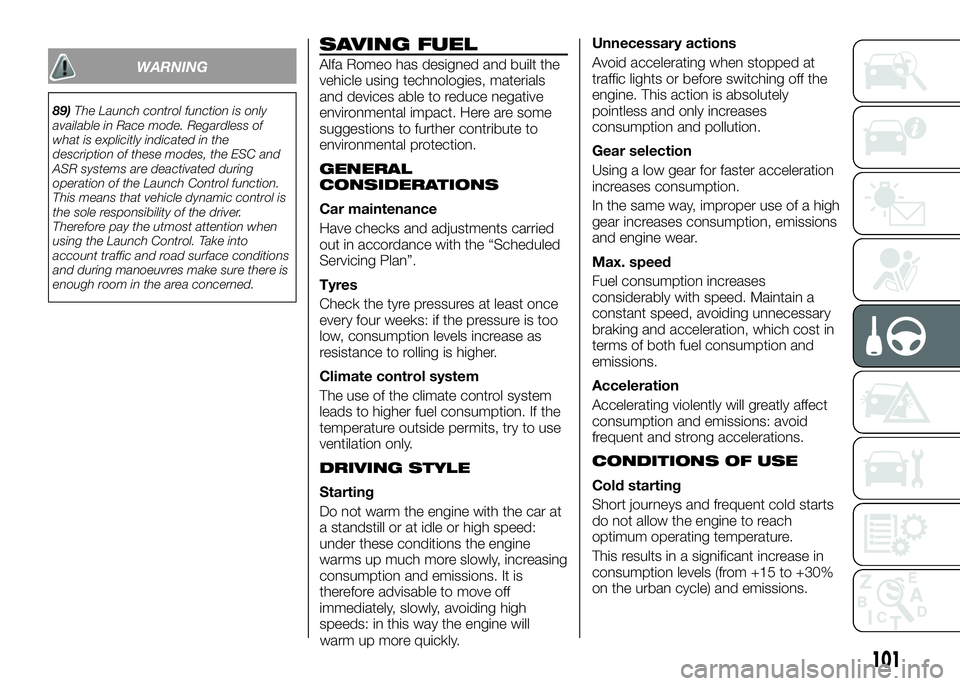
WARNING
89)The Launch control function is only
available in Race mode. Regardless of
what is explicitly indicated in the
description of these modes, the ESC and
ASR systems are deactivated during
operation of the Launch Control function.
This means that vehicle dynamic control is
the sole responsibility of the driver.
Therefore pay the utmost attention when
using the Launch Control. Take into
account traffic and road surface conditions
and during manoeuvres make sure there is
enough room in the area concerned.
SAVING FUEL
Alfa Romeo has designed and built the
vehicle using technologies, materials
and devices able to reduce negative
environmental impact. Here are some
suggestions to further contribute to
environmental protection.
GENERAL
CONSIDERATIONS
Car maintenance
Have checks and adjustments carried
out in accordance with the “Scheduled
Servicing Plan”.
Tyres
Check the tyre pressures at least once
every four weeks: if the pressure is too
low, consumption levels increase as
resistance to rolling is higher.
Climate control system
The use of the climate control system
leads to higher fuel consumption. If the
temperature outside permits, try to use
ventilation only.
DRIVING STYLE
Starting
Do not warm the engine with the car at
a standstill or at idle or high speed:
under these conditions the engine
warms up much more slowly, increasing
consumption and emissions. It is
therefore advisable to move off
immediately, slowly, avoiding high
speeds: in this way the engine will
warm up more quickly.Unnecessary actions
Avoid accelerating when stopped at
traffic lights or before switching off the
engine. This action is absolutely
pointless and only increases
consumption and pollution.
Gear selection
Using a low gear for faster acceleration
increases consumption.
In the same way, improper use of a high
gear increases consumption, emissions
and engine wear.
Max. speed
Fuel consumption increases
considerably with speed. Maintain a
constant speed, avoiding unnecessary
braking and acceleration, which cost in
terms of both fuel consumption and
emissions.
Acceleration
Accelerating violently will greatly affect
consumption and emissions: avoid
frequent and strong accelerations.
CONDITIONS OF USE
Cold starting
Short journeys and frequent cold starts
do not allow the engine to reach
optimum operating temperature.
This results in a significant increase in
consumption levels (from +15 to +30%
on the urban cycle) and emissions.
101
Page 106 of 182
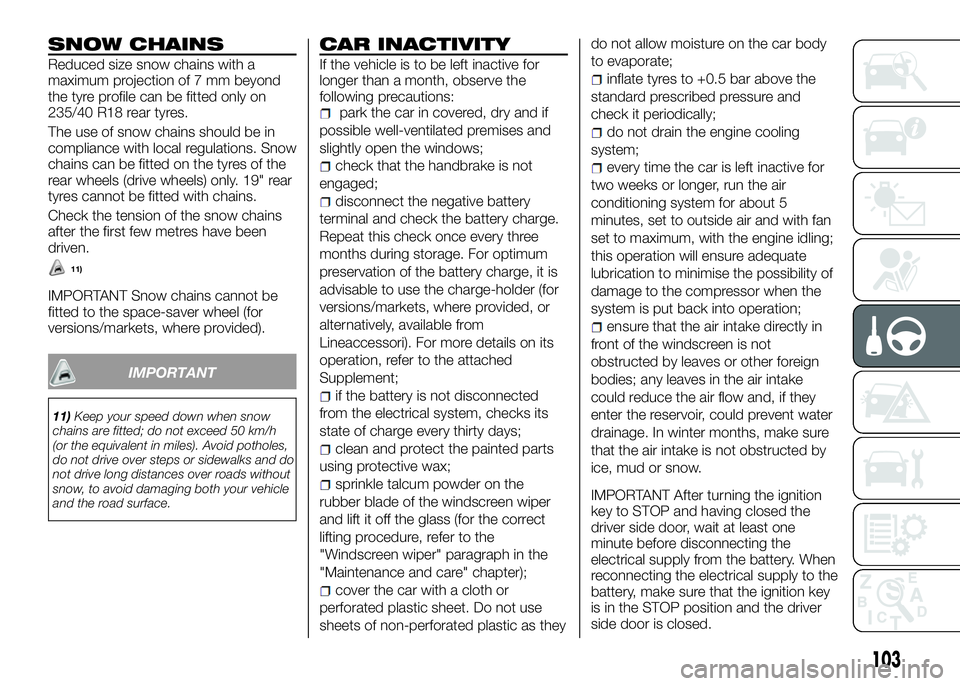
SNOW CHAINS
Reduced size snow chains with a
maximum projection of 7 mm beyond
the tyre profile can be fitted only on
235/40 R18 rear tyres.
The use of snow chains should be in
compliance with local regulations. Snow
chains can be fitted on the tyres of the
rear wheels (drive wheels) only. 19" rear
tyres cannot be fitted with chains.
Check the tension of the snow chains
after the first few metres have been
driven.
11)
IMPORTANT Snow chains cannot be
fitted to the space-saver wheel (for
versions/markets, where provided).
IMPORTANT
11)Keep your speed down when snow
chains are fitted; do not exceed 50 km/h
(or the equivalent in miles). Avoid potholes,
do not drive over steps or sidewalks and do
not drive long distances over roads without
snow, to avoid damaging both your vehicle
and the road surface.
CAR INACTIVITY
If the vehicle is to be left inactive for
longer than a month, observe the
following precautions:
park the car in covered, dry and if
possible well-ventilated premises and
slightly open the windows;
check that the handbrake is not
engaged;
disconnect the negative battery
terminal and check the battery charge.
Repeat this check once every three
months during storage. For optimum
preservation of the battery charge, it is
advisable to use the charge-holder (for
versions/markets, where provided, or
alternatively, available from
Lineaccessori). For more details on its
operation, refer to the attached
Supplement;
if the battery is not disconnected
from the electrical system, checks its
state of charge every thirty days;
clean and protect the painted parts
using protective wax;
sprinkle talcum powder on the
rubber blade of the windscreen wiper
and lift it off the glass (for the correct
lifting procedure, refer to the
"Windscreen wiper" paragraph in the
"Maintenance and care" chapter);
cover the car with a cloth or
perforated plastic sheet. Do not use
sheets of non-perforated plastic as theydo not allow moisture on the car body
to evaporate;
inflate tyres to +0.5 bar above the
standard prescribed pressure and
check it periodically;
do not drain the engine cooling
system;
every time the car is left inactive for
two weeks or longer, run the air
conditioning system for about 5
minutes, set to outside air and with fan
set to maximum, with the engine idling;
this operation will ensure adequate
lubrication to minimise the possibility of
damage to the compressor when the
system is put back into operation;
ensure that the air intake directly in
front of the windscreen is not
obstructed by leaves or other foreign
bodies; any leaves in the air intake
could reduce the air flow and, if they
enter the reservoir, could prevent water
drainage. In winter months, make sure
that the air intake is not obstructed by
ice, mud or snow.
IMPORTANT After turning the ignition
key to STOP and having closed the
driver side door, wait at least one
minute before disconnecting the
electrical supply from the battery. When
reconnecting the electrical supply to the
battery, make sure that the ignition key
is in the STOP position and the driver
side door is closed.
103
Page 108 of 182
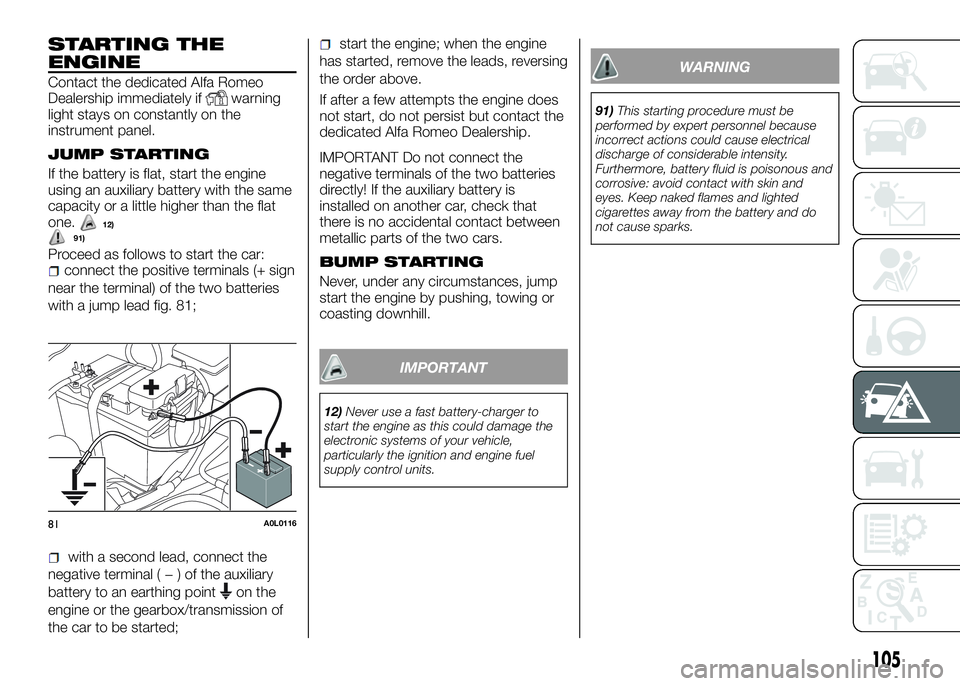
STARTING THE
ENGINE
Contact the dedicated Alfa Romeo
Dealership immediately ifwarning
light stays on constantly on the
instrument panel.
JUMP STARTING
If the battery is flat, start the engine
using an auxiliary battery with the same
capacity or a little higher than the flat
one.
Proceed as follows to start the car:connect the positive terminals (+ sign
near the terminal) of the two batteries
with a jump lead fig. 81;
with a second lead, connect the
negative terminal(−)oftheauxiliary
battery to an earthing point
on the
engine or the gearbox/transmission of
the car to be started;
start the engine; when the engine
has started, remove the leads, reversing
the order above.
If after a few attempts the engine does
not start, do not persist but contact the
dedicated Alfa Romeo Dealership.
IMPORTANT Do not connect the
negative terminals of the two batteries
directly! If the auxiliary battery is
installed on another car, check that
there is no accidental contact between
metallic parts of the two cars.
BUMP STARTING
Never, under any circumstances, jump
start the engine by pushing, towing or
coasting downhill.
IMPORTANT
12)Never use a fast battery-charger to
start the engine as this could damage the
electronic systems of your vehicle,
particularly the ignition and engine fuel
supply control units.
WARNING
91)This starting procedure must be
performed by expert personnel because
incorrect actions could cause electrical
discharge of considerable intensity.
Furthermore, battery fluid is poisonous and
corrosive: avoid contact with skin and
eyes. Keep naked flames and lighted
cigarettes away from the battery and do
not cause sparks.
81A0L0116
105
91)12)
Page 110 of 182
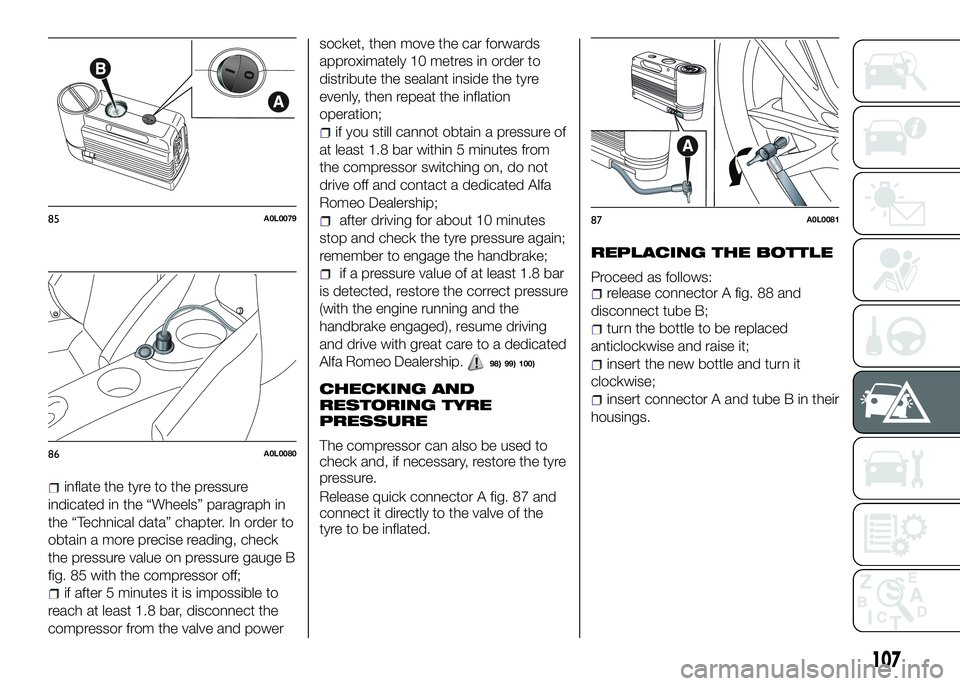
inflate the tyre to the pressure
indicated in the “Wheels” paragraph in
the “Technical data” chapter. In order to
obtain a more precise reading, check
the pressure value on pressure gauge B
fig. 85 with the compressor off;
if after 5 minutes it is impossible to
reach at least 1.8 bar, disconnect the
compressor from the valve and powersocket, then move the car forwards
approximately 10 metres in order to
distribute the sealant inside the tyre
evenly, then repeat the inflation
operation;
if you still cannot obtain a pressure of
at least 1.8 bar within 5 minutes from
the compressor switching on, do not
drive off and contact a dedicated Alfa
Romeo Dealership;
after driving for about 10 minutes
stop and check the tyre pressure again;
remember to engage the handbrake;
if a pressure value of at least 1.8 bar
is detected, restore the correct pressure
(with the engine running and the
handbrake engaged), resume driving
and drive with great care to a dedicated
Alfa Romeo Dealership.
98) 99) 100)
CHECKING AND
RESTORING TYRE
PRESSURE
The compressor can also be used to
check and, if necessary, restore the tyre
pressure.
Release quick connector A fig. 87 and
connect it directly to the valve of the
tyre to be inflated.
REPLACING THE BOTTLE
Proceed as follows:release connector A fig. 88 and
disconnect tube B;
turn the bottle to be replaced
anticlockwise and raise it;
insert the new bottle and turn it
clockwise;
insert connector A and tube B in their
housings.
85A0L0079
86A0L0080
87A0L0081
107
Page 115 of 182
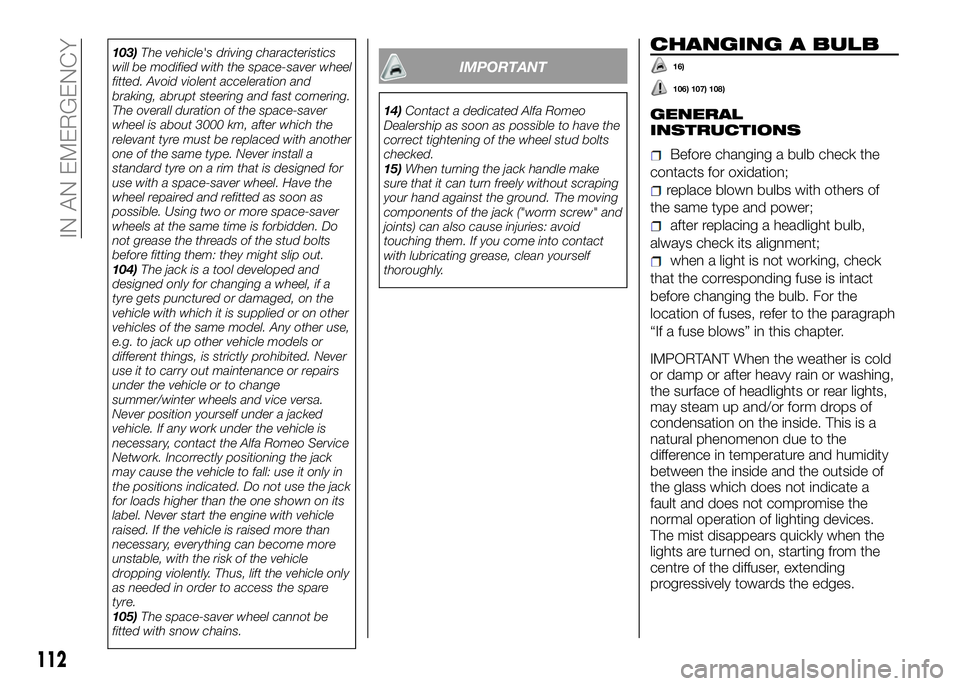
103)The vehicle's driving characteristics
will be modified with the space-saver wheel
fitted. Avoid violent acceleration and
braking, abrupt steering and fast cornering.
The overall duration of the space-saver
wheel is about 3000 km, after which the
relevant tyre must be replaced with another
one of the same type. Never install a
standard tyre on a rim that is designed for
use with a space-saver wheel. Have the
wheel repaired and refitted as soon as
possible. Using two or more space-saver
wheels at the same time is forbidden. Do
not grease the threads of the stud bolts
before fitting them: they might slip out.
104)The jack is a tool developed and
designed only for changing a wheel, if a
tyre gets punctured or damaged, on the
vehicle with which it is supplied or on other
vehicles of the same model. Any other use,
e.g. to jack up other vehicle models or
different things, is strictly prohibited. Never
use it to carry out maintenance or repairs
under the vehicle or to change
summer/winter wheels and vice versa.
Never position yourself under a jacked
vehicle. If any work under the vehicle is
necessary, contact the Alfa Romeo Service
Network. Incorrectly positioning the jack
may cause the vehicle to fall: use it only in
the positions indicated. Do not use the jack
for loads higher than the one shown on its
label. Never start the engine with vehicle
raised. If the vehicle is raised more than
necessary, everything can become more
unstable, with the risk of the vehicle
dropping violently. Thus, lift the vehicle only
as needed in order to access the spare
tyre.
105)The space-saver wheel cannot be
fitted with snow chains.IMPORTANT
14)Contact a dedicated Alfa Romeo
Dealership as soon as possible to have the
correct tightening of the wheel stud bolts
checked.
15)When turning the jack handle make
sure that it can turn freely without scraping
your hand against the ground. The moving
components of the jack ("worm screw" and
joints) can also cause injuries: avoid
touching them. If you come into contact
with lubricating grease, clean yourself
thoroughly.
CHANGING A BULB
16)
106) 107) 108)
GENERAL
INSTRUCTIONS
Before changing a bulb check the
contacts for oxidation;
replace blown bulbs with others of
the same type and power;
after replacing a headlight bulb,
always check its alignment;
when a light is not working, check
that the corresponding fuse is intact
before changing the bulb. For the
location of fuses, refer to the paragraph
“If a fuse blows” in this chapter.
IMPORTANT When the weather is cold
or damp or after heavy rain or washing,
the surface of headlights or rear lights,
may steam up and/or form drops of
condensation on the inside. This is a
natural phenomenon due to the
difference in temperature and humidity
between the inside and the outside of
the glass which does not indicate a
fault and does not compromise the
normal operation of lighting devices.
The mist disappears quickly when the
lights are turned on, starting from the
centre of the diffuser, extending
progressively towards the edges.
112
IN AN EMERGENCY
Page 123 of 182
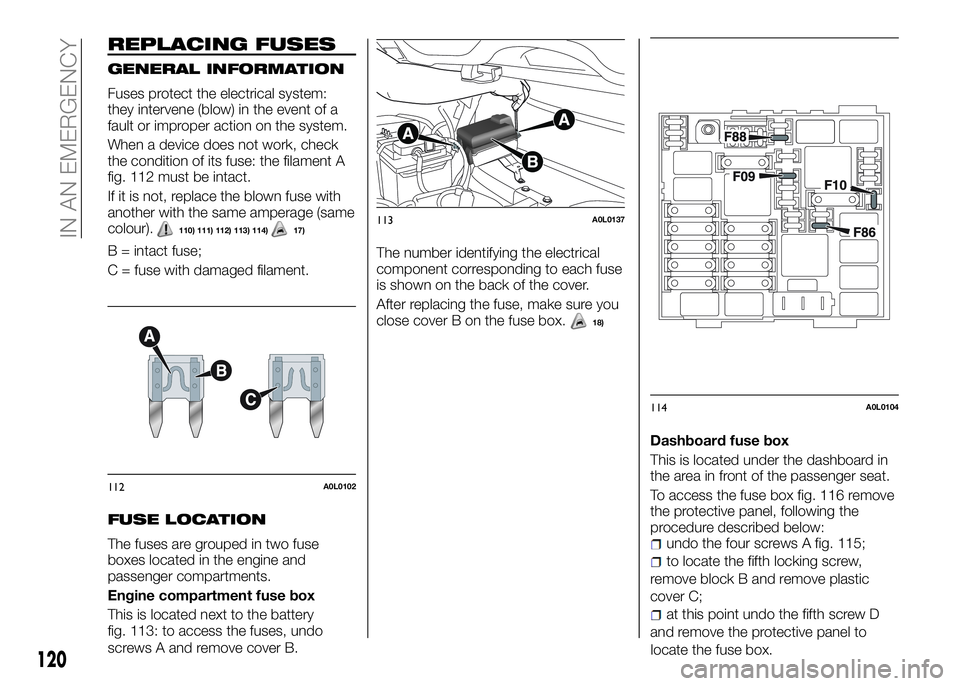
REPLACING FUSES
GENERAL INFORMATION
Fuses protect the electrical system:
they intervene (blow) in the event of a
fault or improper action on the system.
When a device does not work, check
the condition of its fuse: the filament A
fig. 112 must be intact.
If it is not, replace the blown fuse with
another with the same amperage (same
colour).
110) 111) 112) 113) 114)17)
B = intact fuse;
C = fuse with damaged filament.
FUSE LOCATION
The fuses are grouped in two fuse
boxes located in the engine and
passenger compartments.
Engine compartment fuse box
This is located next to the battery
fig. 113: to access the fuses, undo
screws A and remove cover B.The number identifying the electrical
component corresponding to each fuse
is shown on the back of the cover.
After replacing the fuse, make sure you
close cover B on the fuse box.
18)
Dashboard fuse box
This is located under the dashboard in
the area in front of the passenger seat.
To access the fuse box fig. 116 remove
the protective panel, following the
procedure described below:
undo the four screws A fig. 115;
to locate the fifth locking screw,
remove block B and remove plastic
cover C;
at this point undo the fifth screw D
and remove the protective panel to
112A0L0102
113A0L0137
114A0L0104
120
IN AN EMERGENCY
locate the fuse box.
Page 128 of 182
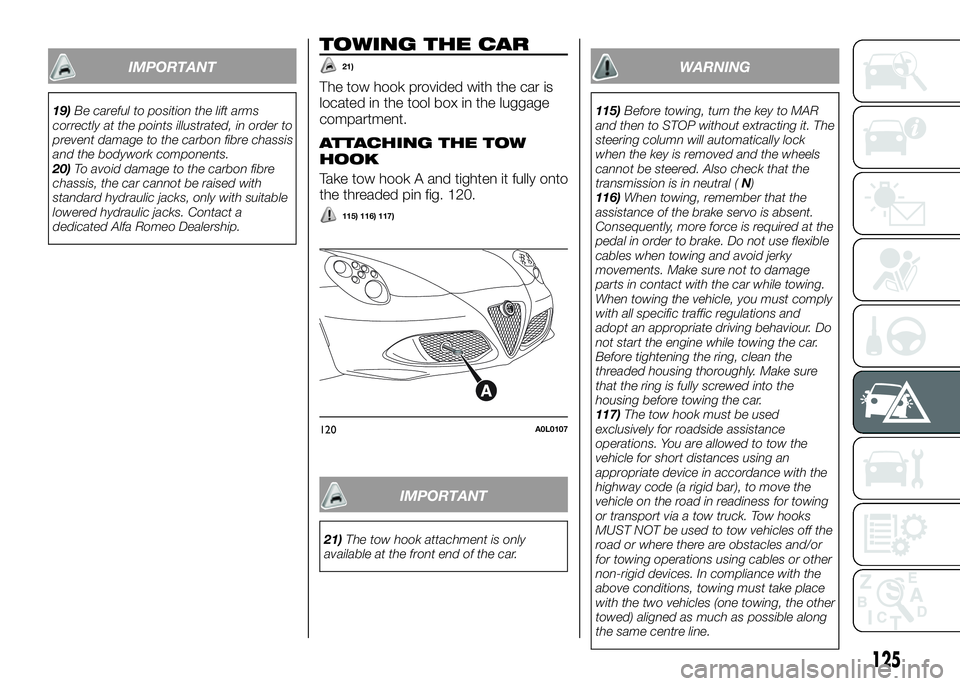
IMPORTANT
19)Be careful to position the lift arms
correctly at the points illustrated, in order to
prevent damage to the carbon fibre chassis
and the bodywork components.
20)To avoid damage to the carbon fibre
chassis, the car cannot be raised with
standard hydraulic jacks, only with suitable
lowered hydraulic jacks. Contact a
dedicated Alfa Romeo Dealership.
TOWING THE CAR
21)
The tow hook provided with the car is
located in the tool box in the luggage
compartment.
ATTACHING THE TOW
HOOK
Take tow hook A and tighten it fully onto
the threaded pin fig. 120.
115) 116) 117)
IMPORTANT
21)The tow hook attachment is only
available at the front end of the car.
WARNING
115)Before towing, turn the key to MAR
and then to STOP without extracting it. The
steering column will automatically lock
when the key is removed and the wheels
cannot be steered. Also check that the
transmission is in neutral (N)
116)When towing, remember that the
assistance of the brake servo is absent.
Consequently, more force is required at the
pedal in order to brake. Do not use flexible
cables when towing and avoid jerky
movements. Make sure not to damage
parts in contact with the car while towing.
When towing the vehicle, you must comply
with all specific traffic regulations and
adopt an appropriate driving behaviour. Do
not start the engine while towing the car.
Before tightening the ring, clean the
threaded housing thoroughly. Make sure
that the ring is fully screwed into the
housing before towing the car.
117)The tow hook must be used
exclusively for roadside assistance
operations. You are allowed to tow the
vehicle for short distances using an
appropriate device in accordance with the
highway code (a rigid bar), to move the
vehicle on the road in readiness for towing
or transport via a tow truck. Tow hooks
MUST NOT be used to tow vehicles off the
road or where there are obstacles and/or
for towing operations using cables or other
non-rigid devices. In compliance with the
above conditions, towing must take place
with the two vehicles (one towing, the other
towed) aligned as much as possible along
the same centre line.
120A0L0107
125